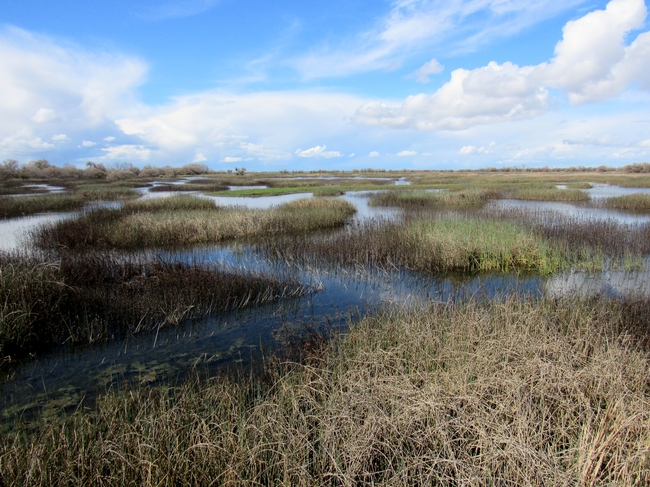Guest author Siera Nystrom is a certified UC Merced Vernal Pools and Grassland Reserve California Naturalist, and writes about the Sacramento and San Joaquin Biogregions for California Biodiversity Week 2021. You can follow more of Siera's writings posted on Notes from a California Naturalist.
September marks the beginning of a great awakening across California's Great Central Valley. As summer fades quietly into the warm, golden tints of autumn, long-absent birds begin to return, filling sleepy wetlands with sound and color and motion, the throbbing pulse of life.
Scattered up and down the Central Valley, carefully engineered wetlands, many of which are managed by the U.S. Fish and Wildlife Service as National Wildlife Refuges, provide pockets of protected habitat, humble but precious remnants of what was once an extensive system of freshwater marshes, sloughs and riparian corridors, linked together within a mosaic of arid upland habitats stretching the length of the Valley.
Native Yokut people, who have long called this beautiful valley their home, make wise use of the natural abundance found here, their lives intertwined with and dependent on the bounty of the wetlands. Tule reeds, which grow in the still, freshwater marshes and sloughs once so characteristic of this region, provide plentiful food and fiber, while the marshes themselves afford valuable habitat for a seasonal abundance of waterfowl, a rich and reliable food source for the Yokut.
The majority of the Central Valley's freshwater marsh habitat has long since disappeared – and with the wetland, her people. Diked and drained, paved and plowed beyond recognition during the nineteenth and early twentieth centuries, the once abundant freshwater marshes of the Valley vanished at the hand of progress.
Like the coming of the first autumn rains, the mid-twentieth century once again brought change to the Valley's wetlands: change and hope. Through the Herculean efforts of both government and private organizations, with the cooperation of conservation-minded landowners, wetland restoration began in earnest.
Three quarters of a century later, the Central Valley wetlands of today are a far cry from the wild places they once were before European settlers arrived. Though highly fragmented and intensively managed, freshwater marshes in the Central Valley persist as functional blocks of priceless habitat for the wide array of plants and animals that rely on them. And, most importantly, they are protected in perpetuity.
Though the damage to Central Valley wetlands can never be undone, it can be somewhat mitigated: water can be redirected to fill dry sloughs and sinks, native plants can be regrown. The tules themselves breathe new life into rehabilitated wetlands, drawing wildlife into their sheltering thickets. Migratory birds are drawn by instinct to the mild winter climate of the Central Valley, following ancient flyways to return each autumn to their ancestral overwintering grounds.
Yes, hope remains for the diverse assemblage of species that rely on Valley wetland habitats.
A cursory glance across the Central Valley landscape from the highway belies its true value. What the casual observer sees are rural communities, sprawling towns and cities, and the intensive farming operations of one of the most productive agricultural regions in the U.S. But tucked away, hidden within the rigid patchwork blocks of almond orchards and corn fields, are the sinuous curves of meandering sloughs and marshes, painstakingly carved out of the landscape and set aside for the birds – and for the future.
During the short, gray days of winter, waterfowl overwhelm the wetlands: ducks and geese swirl through the air like avian confetti, and blanket open water like drifts of snow; Tundra Swans glide through dense tule fog like apparitions, emissaries from the Arctic.
With the coming of spring, the animated chatter of Marsh Wrens, buzzing notes of Song Sparrows and rollicking songs of Common Yellowthroats fill wetlands with a joyous chorus, the sound of life reveling in a landscape that has suddenly cast off her somber winter tones in exchange for vibrant green finery.
But spring is fleeting, and all at once Valley wetlands are plunged into the heat of yet another seemingly endless summer, the lush growth of April rapidly fading to the dry, muted shades of August. Pools of water shrink before drying completely to reveal basins of cracked mud. All is still and quiet in the wetland, save the soft droning of dragonfly wings and the rustling of dry reeds in a hot breeze.
After sleeping through the long, dry days of summer, tule marshes awaken in the autumn with the return of countless millions of birds, from raptors and songbirds, to waterfowl and shorebirds. And with them come perhaps the most iconic Central Valley bird of them all, the Sandhill Crane.
From late September through the end of March, these elegant, three-foot tall birds grace Central Valley wetlands with their stately presence, bestowing on the tule marshes a certain dignity that is lacking in their absence. Large flocks of Sandhill Cranes spend the winter months in the gold-and-gray landscape of Central Valley marshes, dancing and grazing in fields of grain grown especially for them. In a scene that has remained unchanged for countless generations, trailing skeins scrawl across the sky, silhouetted against the sunset as the cranes fly in for the night, seeking refuge in the wetlands.
With autumn on the way again, the marshes know that change is coming: change and hope. Slowly, quietly, imperceptibly at first, the seasons begin to shift. Morning mist lies heavily over the water; a cool breeze stirs; cottonwood leaves fade from green to gold. With any luck, the autumn rains begin.
And once again, the birds return to this special place, the place their ancestors have relied on for millennia. Once again, the cranes' bugling cries sound across foggy marshes, haunting echoes of the prehistoric heart and soul of the Great Central Valley.
September 4-12, 2021 is California Biodiversity Week. Join us in celebrating the unique biodiversity and renewing our commitment to stewarding the state's incredible natural heritage! During the Week, CalNat is posting blogs authored by members of our community, ending in our September 14th CONES event from noon-1:00 PM. Be sure to also check out a list of activities and resources online from the CA Natural Resources Agency!

